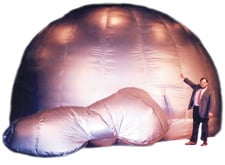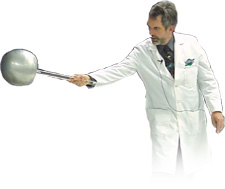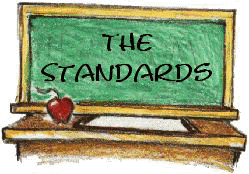 School Assemblies and State Standards - Sky Dome Planetarium
School Assemblies and State Standards - Sky Dome Planetarium
I love National Public Radio! Listening to NPR on my way to the office in the morning I often hear about things that are fascinating and about which I knew nothing before.
This morning there was a piece on a new astronomical event. Apparently, in 1979, a star was observed exploding into a Super Nova. But this was no ordinary event. It seems the explosion was large enough that it may have produced a black hole. And evidence suggests that this hole has, in the last thirty years, consumed an amount of mass equal to that of our entire planet, which, as these things go, is a lot! And this seems to be the very first time astronomers have been able to witness a black hole being born in a normal Super Nova. Way cool!
And this got me to thinking about, of course, school assemblies. Kids love this stuff. They love the stars, and astronomy. And aspects of astronomy and earth science are all through the state standards in most states. And yet there is often a disconnect between the innate curiosity of kids in this regard, and the teaching of the subject in school.
Not long ago I was out on a Boy Scout outing with my son’s scout troop and we had with us a young scout from an inner city neighborhood. That night, after all the young guys had turned in, but when the adults were still up chatting around a small fire, this young man got up to see what was going on. It was a clear night and by chance he looked up and was instantly transfixed by the sheer number and brilliance of the stars that were visible that night. Growing up in the city, he had had no idea of the number of stars to be seen on a clear dark night outside the lights of the city. He must have stood there for a good 45 minutes just lost in wonder. It was a great teachable moment and we used it to point out a few of the better known constellations. It was a great night!
But many young people never get that opportunity, and the context within a classroom is often so disconnected as to leave the students struggling to find the passion.
Yet they need to learn about the universe as this area is directly specified in the educational standards of most states,
Take the standards of Kentucky for an example. Here is a quoted section from the primary standards:
“SC-EP-2.3.3
Students will describe the properties, locations and real or apparent movements of objects in the sky (Sun, moon).
Objects in the sky have properties, locations and real or apparent movements that can be observed and described. Observational data, patterns and models should be used to describe real or apparent movements. “
And here is one from the fifth grade standards:
“SC-05-2.3.5
Students will compare components of our solar system, including using models/representations that illustrate the system.
Earth is the third planet from the Sun in a system that includes the moon, the Sun, eight other planets and their moons, and smaller objects. The Sun, an average star, is the central and largest body in the solar system. Models/diagrams provide understanding of scale within the solar system.”
And from the seventh:
“SC-07-2.3.3
Students will describe the concept of gravity and the effect of gravitational force between the sun, moon and Earth.
The gravitational pull of the Sun and moon on Earth's oceans as the major cause of tides can be understood from generalizations based on evidence. “
Well, here is where school assembly programs can be of enormous value to a school. Far from a simply entertaining distraction, programs such as SKY DOME Planetarium, cater directly to educational standards such as these, but do so in a fascinating, kid-friendly manner that encourages excitement and a desire to learn more. Seated within a huge dome (30 feet in diameter and some 16 feet tall, students witness our universe by way of a state of the art digital star projector which shows all aspects of the universe if which we live through stunning computer generated special effects, all the while accompanied by narration provided by a trained professional presenter. If you are looking for school assembly program ideas, science assemblies, or alternatives to field trips it doesn’t get much better than Sky Dome!
And to top it off, the presenter is even able to replicate the effects of a black hole. So should one of the students happen to be traveling in a car with an NPR addicted Dad, and should they happen to hear the same report this Dad heard this morning, it may well be the student who says “ Hey, Dad, turn that up. That’s the thing we heard about in the Sky Dome!”
And it really doesn’t get any better than that!
Science Assembly Programs and State Standards Part 2
Last time we looked at how programs such as Skydome Planetarium meet State Educational Standards in science. Now I would like to continue that discussion with a look at another scientific discipline, chemistry.
We all know science is important and we all know our kids are not doing well in this area and that we need to do better... President Obama was just the latest in an unbroken line of presidents espousing this need when he said that the “hard truth” is that American kids have “been losing ground” in science and math education. If fact, recent studies show 15 year old American students rank 25th in the world in these areas. Clearly we need action!
But most classrooms are at a disadvantage in teaching science since many lack exotic props and gizmos of the kind that excite kids. Kids often think science is just plain boring! And yet, they will happily sit and watch television programs like Mythbusters, where science is employed every week. Why? Simple. Explosions, fire, cars ramming into walls at high speed and so on. Kids love this stuff!
But how to get it across in a classroom in a way that kids find exciting?
Most states have facets of their elementary curriculum that deal with basic chemistry. The three states of matter, how matter changes, solubility etc. Let’s look at Kentucky again for example. Here is a section taken from the standards in Kentucky relating to primary grades:
SC-EP-1.1.3
Students will describe the properties of water as it occurs as a solid, liquid or gas.
Matter (water) can exist in different states--solid, liquid and gas. Properties of those states of matter can be used to describe and classify them.
DOK 2
And here is a section from the fourth grade:
SC-04-1.1.1
Students will explain how matter, including water, can be changed from one state to another.
Materials can exist in different states--solid, liquid and gas. Some common materials, such as water, can be changed from one state to another by heating or cooling. Resulting cause and effect relationships should be explored, described and predicted.
DOK 3
And here is one from the fifth grade
SC-05-1.1.1
Students will describe the physical properties of substances (e.g., boiling point, solubility, density).
A substance has characteristic physical properties (e.g., boiling point, solubility, density) that are independent of the amount of the sample.
DOK 2
Here is where school assemblies, and particularly school science assemblies function perfectly! Take a science assembly such as our Chemistry! It Really Matters! In this great school assembly program we examine the three states of matter, the scientific method, exothermic and endothermic reactions, poly foam creation, along with various exotic effects such as subzero blasts of liquid nitrogen, fireballs and explosions. Show me an elementary student anywhere that won’t be excited by that! And when the program is done, not only have we reinforced what the students are supposed to be learning, we have also dazzled them in a way that sends them back to class eager to learn more. And all of this in the very area that they must learn and which they normally find boring!
Wow!
Next time - State Standards and the physical sciences!
 Science Assemblies and State Standards - Physical Science
Science Assemblies and State Standards - Physical Science
Lately we have been discussing state educational standards and the ways in which they may be supported by quality educational assembly programs.
Looking again at the standards for the state of Kentucky, as laid out by the Kentucky Department of Education, here are two excerpts detailing some of what is expected by the end of Primary grades:
SC-EP-1.2.1
Students will describe and make inferences about the interactions of magnets with other magnets and other matter (e.g., magnets can make some things move without touching them).
SC-EP-1.2.3
Students will describe the position and motion of objects and predict changes in position and motion as related to the strength of pushes and pulls.
Here is are a couple of sections from the 4th Grade:
SC-04-1.2.1
Students will interpret or represent data related to an object's straight-line motion in order to make inferences and predictions of changes in position and/or time.
SC-04-1.2.2
Students will infer causes and effects of pushes and pulls (forces) on objects based on representations or interpretations of straight-line movement/motion in charts, graphs and qualitative comparisons.
Forces and Motion is a science assembly which is not only very entertaining, but which also has specific sections dealing with each of these areas. Physics is Fun also touches on some of the same material (especially in our hands on workshop format), but also delves nicely into the area of sound waves. Sound as a category of study shows up as an area of importance in its own right with the fourth grade as detailed here:
SC-04-1.2.3
Students will:
o explain that sound is a result of vibrations, a type of motion;
o describe pitch ( high, low) as a difference in sounds that are produced and relate that to the rate of vibration.
Vibration is a type of motion that can be observed, described, measured and compared. Sound is produced by vibrating objects. The pitch of the sound can be varied by changing the rate of vibration. The relationship between rates of vibration and produced sounds can be described and graphed.
Many other examples also appear throughout the standards of Kentucky, and most likely throughout the standards for your state, too. By scheduling an assembly which contains direct references to, and examples of, material dictated by state standards, a school not only provides the excitement of a break from classroom routine, and a welcome hour of entertainment, but also works directly to reinforce what the students are supposed to be learning.
Moments from live school assemblies are powerful teaching tools. Sometimes they serve to illustrate a point directly but sometimes they may also serve to excite the imaginations of students. Then when the same material is broached in the classroom the students are eager to learn more because they have seen the potential “coolness” inherent in that particular field.
And we all know, learning is far more likely to take place when the subject is something “cool”!
Science does not have to be boring. In fact, when presented well, science is exciting, fun and very, very cool!
“Teaching to the Test” and School Assembly Programs
If you read this blog often you will know I listen to NPR a lot. Today was no exception. At lunchtime I was out to pick up a sandwich and got stuck listening to a pair of interviews on Fresh Air with Terry Gross that concerned education in the United States. The first was a fascinating interview with former Assistant Secretary of Education Diane Ravitch, explaining what changed her mind on No Child Left Behind, school vouchers and charter schools.
http://www.npr.org/2011/04/28/135142895/ravitch-standardized-testing-undermines-teaching
This was followed by another interview but this time with educational consultant Andrew Rotherham explaining why he supports the very issues that Ms. Ravitch now opposes.
http://www.npr.org/2011/04/28/135802562/rotherham-dont-discount-charter-school-model
Both were really great interviews, and though their views were in opposition, it was obvious that both cared deeply about the state of education, and the welfare of our children. I do not want to get involved in the debate over charter schools, mandatory testing and school vouchers, but I do recommend listening to both interviews!
What struck me, though, was a comment that came from Mr. Ravitch. Working with teachers and principals every day, I often hear about the stresses and strains they face because of mandatory testing and how it has increased so dramatically since the beginning of No Child Left Behind. The subject of “teaching to the test” sometimes arises. For those who do not know, this refers to the practice of some teachers, schools and school districts, worried about their test scores and the prospect of losing funding if their scores are bad, to spend most of their school day teaching only what kids will face on their tests. So if a subject is not tested, as for example, music, then music may be downplayed in the students weekly regimen or eliminated completely.
What caught my ear was a comment from mr. Ravitch. When asked about this practice, of “teaching to the test” he said basically said that studies have shown that it doesn’t necessarily help nor is it a good practice. His comment was that the schools that forgo concentrating only on tested material and instead present a “rich teaching curriculum” usually score the best on the tests in the end. Counter intuitive? Not really.
As we have observed before, children's minds, and, for that matter, the minds of adults, do not all learn the same way, nor are all of equally well equipped to learn different subjects. Where one may excel at reading but be shy in regard to personal relationships, another may see only lines on a page but make friends easily. The football star be be terrible at math while the math wizard may have no physical agility at all. Nonetheless, an adept teacher knows that by identifying and supporting a students strong suits, it is often possible to encourage improvement in other areas. In other words, a “rich” and varied field of instruction helps all kids because they learn in different ways and improvement in one area facilitates improvement in other areas. Simply beating on math and reading all day has the opposite (and unintended) result.
So here is where we come to my favorite topic - school assemblies. Every day we run across teachers and principals who refuse to schedule exciting and curriculum supporting educational assemblies because they want the kids to have “time on task”. We hear it again and again. Time on task. Counter intuitive. Supporting a “rich teaching curriculum” by including regular exposure to non traditional learning through activities like school assemblies is exactly what will improve scores on testing the most. Counter intuitive, but correct.
Jim Felix, one of the wisest principals I ever met and who helmed the school where my kids attended elementary grades, once observed to me why he believed kids at his school did so well on testing. He said he believed it was the number and variety of science and other forms of educational school assemblies to which the students there were exposed regularly. Wise man. Sage advice.
So the next time you are faced with the prospect of increasing testing in math or reading, consider scheduling a live animal science assembly, or aportable planetarium, or a visit from Ben Franklin. You may be very pleasantly surprised at the results!

 Every school strives to meet educational standards set by the school's State Department of Education. Sometimes this is a struggle. But Mobile Ed's science assemblies have proven to be of great benefit in this area in many schools. Standards, of course, vary across the country by state. Here are some articles dealing with how Mobile Ed science assemblies meet the standards of some states. Similar outcomes are predicted in other states as well.
Every school strives to meet educational standards set by the school's State Department of Education. Sometimes this is a struggle. But Mobile Ed's science assemblies have proven to be of great benefit in this area in many schools. Standards, of course, vary across the country by state. Here are some articles dealing with how Mobile Ed science assemblies meet the standards of some states. Similar outcomes are predicted in other states as well.
